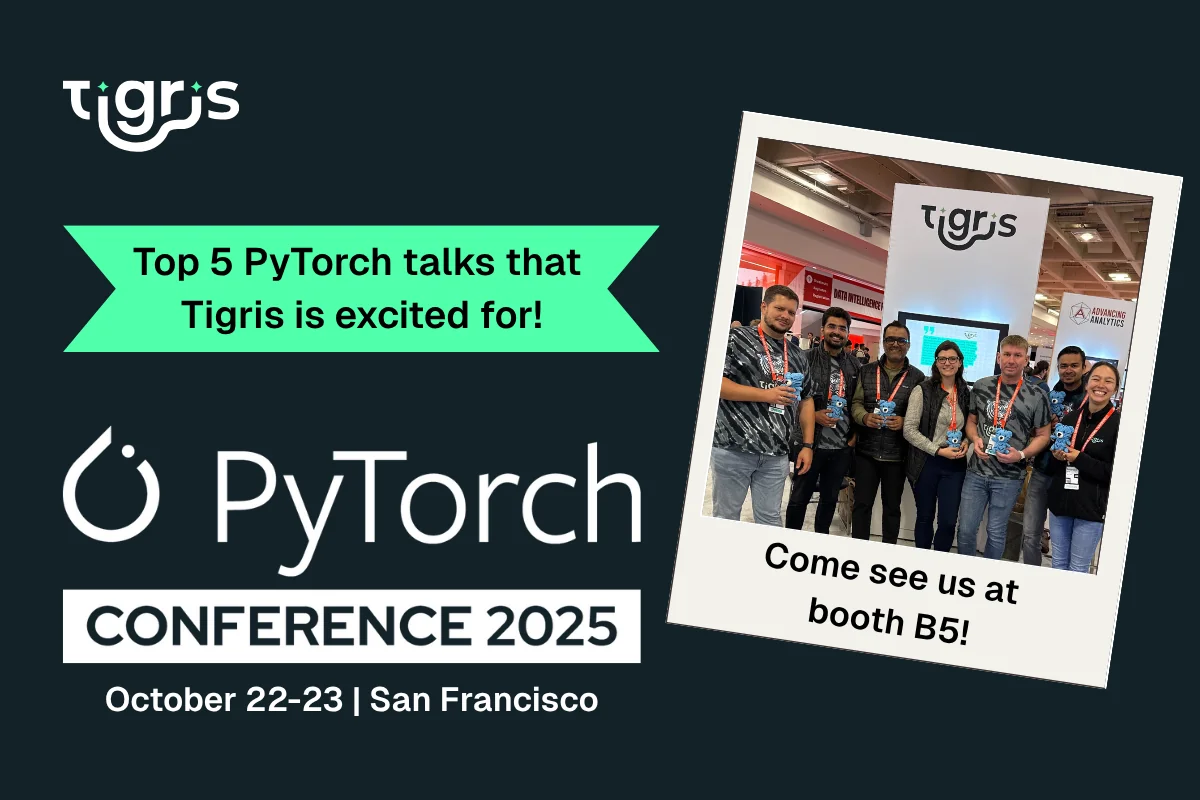What Tigris Data Is Excited About at PyTorch Conference 2025

What Tigris Data Is Excited About at PyTorch Conference 2025
With PyTorch Conference 2025 kicking off in San Francisco next week (Oct 22-23),
we're gearing up to connect with PyTorch developers and dive deep into the
sessions pushing the boundaries of AI infrastructure, storage, and
performance.
Here are the five talks we're most looking forward to, each one showcasing
performance optimizations for AI workloads.
1. Scaling KV Caches for LLMs: How LMCache + NIXL Handle Network and Storage Heterogeneity (NVIDIA, University of Chicago)
Large Language Models generate huge key–value caches, and this session by Junchen Jiang (University of Chicago) and Moein Khazraee (NVIDIA) explores how LMCache makes these caches reusable across memory tiers — from GPU RAM to object storage — while NIXL accelerates transfers across heterogeneous storage and network backends.
It’s a dive into smart caching for AI workloads, the kind of intelligent data movement we think about daily at Tigris when building globally distributed storage systems.
2. Enabling Lightweight, High-Performance FSDP With NVIDIA GPU (NVIDIA)
This
talk
by Xuwen Chen, Jianbin Chang, Sangkug Lym, and Cory Ye (all NVIDIA) dives
into NVIDIA’s optimized implementation of Fully Sharded Data Parallel (FSDP).
By offloading collective communication to NVLink and InfiniBand SHARP and
reducing GPU memory fragmentation, they achieve remarkable training efficiency.
It’s a perfect showcase of hardware-aware optimization, where deep learning frameworks evolve to squeeze every ounce of performance from modern compute infrastructure.
3. Amazingly Fast and Incredibly Scalable Inference With NVIDIA’s Dynamo and TensorRT-LLM (NVIDIA)
In this session, Harry Kim and Laikh Tiwari (NVIDIA) pair NVIDIA Dynamo’s disaggregated inference architecture with TensorRT-LLM’s optimized execution engine. It shows lightning-fast model serving through intelligent workload splitting and GPU kernel optimization.
It’s the kind of performance-first engineering that mirrors how we enable high-throughput data pipelines at Tigris — precise, efficient, and scalable.
4. Efficient MoE Pre-training at Scale on AMD GPUs With TorchTitan (AMD, Meta)
This talk by Liz Li (AMD), Yanyuan Qin (AMD), and Less Wright (Meta) showcases how TorchTitan scales massive Mixture-of-Experts (MoE) models on AMD MI300X GPUs.
With 4D parallelism, FP8 precision, and PyTorch-native distributed training, it highlights how PyTorch is becoming more open, flexible, and hardware-agnostic — an exciting direction for AI infrastructure engineers building across diverse compute environments.
5. No GPU Left Behind: Scaling Online LLM Training With Co-located vLLM in TRL (IBM Research)
In this session, Mert Toslali and Yu Chin Fabian Lim (IBM Research) tackle inefficiencies in LLM training loops by co-locating inference and training on the same GPUs. This clever design removes network latency, eliminates idle GPUs, and improves throughput by 1.7×.
It’s a brilliant example of smart system placement — moving computation to where data already lives — a principle we embrace when building performance-critical distributed infrastructure.
Why These Talks Stand Out for Infrastructure Engineers
All five sessions share a common thread: they treat performance as a first-class goal. Each talk digs into eliminating bottlenecks, improving caching, or optimizing hardware utilization. From LMCache’s multi-tier cache strategy to vLLM’s co-located inference, these sessions prove that efficiency often comes not from bigger machines but from smarter design. Data locality, reuse, and reduced latency are recurring themes, echoing what we see daily in distributed storage and database systems. The best latency, after all, is no latency — when data is already where it needs to be.
From NVIDIA’s NVLink and InfiniBand offloads to AMD’s MI300X-based MoE training, PyTorch developers are using hardware-aware optimizations to redefine what scale looks like. Together, they reveal how infrastructure innovation — caching layers, optimized pipelines, distributed coordination — is shaping the next generation of generative AI. The PyTorch community continues to blur the lines between ML research and infrastructure craftsmanship, and these sessions show that innovation often happens where storage, compute, and architecture meet.
At Tigris, we build the storage layer for developers who care about performance, reliability, and simplicity. We're looking forward to incorporating what we learn into our storage layer.
See you in San Francisco!
Want to keep up with us the conference live? Follow @TigrisData for live updates during PyTorch Conference 2025.
Power Your AI Infrastructure with Tigris
Ready to build on high-performance storage? Join the developers scaling AI workloads with Tigris.